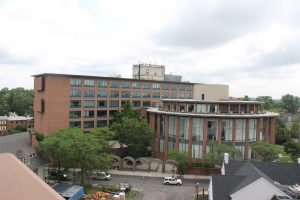
The 153-page Bucks County Transition Team evaluation has been released.
The report was put together by more than 65 volunteers with experience in numerous fields, including some who are in elected office, work for, or are involved in local Democratic politics. However, the report’s contents did not appear to have overt political overtones.
The report examined county government, services to the public, and county-owned assets. The different subcommittees talked with residents and county staff and reviewed operations in recent months while formulating their plans.
Tom Jennings, a Lower Makefield attorney who works with FisherBroyles LLP, commended the commissioners during a virtual Thursday press conference for undertaking the widespread review of operations even though it was not required when the new majority took over.
At their Wednesday meeting, Commissioners Diane Ellis-Marseglia, Bob Harvie and Gene DiGirolamo – two Democrats and a Republican – voted to accept the report and get to work reviewing and implementing some of its recommendations.
Ellis-Marseglia, the commissioners chairperson, said she sees the report as a “strategic plan” for county leadership.
“This is a strategic way we want to go about dealing with those areas,” she said.
Harvie noted that not all changes will be enacted, but the report paints a path forward.
“Overall, we found a county leadership team that is talented, highly experienced, and motivated to serve the residents of Bucks County. These division and department leaders are proud of the work their units do for our residents and approach their roles with the perspectives of true public servants. And there is much to be proud of. We heard about several programs that were considered best of class in our region, and departments that were excited about doing more with less, having proactively introduced cost savings and headcount reductions in an effort to be the best possible stewards of our tax payer dollars,” the Government Efficiency Subcommittee wrote in their report, adding there is “bound to be room for improvement.”
Some key recommendations from the report are that the county should work with all departments to reduce spending by $8 million this year to balance the budget; freeze open job requisitions and resubmit them through a hiring board; consider the future for non-essential facilities, like little or unused properties; encourage departments that bring in revenue to find ways to increase the amount of income; continue livestreaming of public meetings; improve the county website and ways the county communicates; overhaul the information technology operations; find ways to bring new businesses, grow existing businesses, and improve ways to develop new employment and business opportunities; consolidate some economic development and housing operations; look to purchase solar electricity while adopting a net-zero carbon emissions goal of 2045; help farmers market their goods; work to improve some park properties; play a bigger role in promoting and expanding affordable housing; and do more to reduce homelessness.
The Budget and Finance Subcommittee report noted that the county expected a roughly $8 million budget shortfall in 2020. With COVID-19, the latest budget estimate would put the county at break even, noting hiring has been stalled due to the pandemic and refinancing of debt.
The fund balance for the end of 2020 is expected to be $30 million, down from about $64 million just a decade ago. Seven of the past 10 budgets have featured deficits as operating costs have increased, the Budget and Finance Subcommittee said.
“In summary, the County will continue to face financial pressure due to increasing social service needs, coupled with the likely long-term impact of the COVID crisis. We recommend a financial plan be established based on the County’s strategic plan to avoid a potential credit rating downgrade and a drain of the general fund,” the subcommittee stated.
The Communications and Information Technology Subcommittee suggested the county move from three data centers to two with one being outside of the county for continuity reasons. They also suggested a penetration test to evaluate the security of the county’s system and better vetting for reviewing security options from technology vendors.
“We were dismayed to learn that the County was offered a free (penetration) test by the PA National Guard in 2017 and turned it down,” the subcommittee wrote.
Additionally, the subcommittee noted that staffing in the county Information Technology Department has gone from 73 employees in 2009 to 38 employees as of 2020. Over the years, a “shadow IT” has grown to the point where 21 employees in other parts of county government now handle functions that could be dealt with by the Information Technology Department.
The subcommittee noted that an “assessment of the County IT environment” by Computer Aid Inc. of Allentown for $85,000 was kept secret from employees and the transition team. However, they learned that the report called for an increase in department staffing levels.
“One County Employee filed a right to know request to gain access to the study and was rebuffed,” the subcommittee noted.
In their report, the Economic Development Subcommittee recognized the many strengths of Bucks County, including location, population, the schools, and natural beauty. They pointed to drawbacks of the county having a lack of ethnic and racial diversity, limited public transit outside of the lower end of the county, few large employers, disconnected economic development entities, the county being viewed as three separate sections, and a growing cost of living. In addition, it noted public and private collaborations, the port in Falls Township, room for new housing to entice younger professionals, good internet access, opportunities for redevelopment of industrial sites near major transitways, and strength of county tourism agency were opportunities for growth.
The Environment and Energy Subcommittee called for the commissioners to put a $110 million bond referendum for either the November election of the May 2021 election to finance open space acquisition and protection, the preservation of farmland and historic sites, and brownfield remediation. A similar program was previously in place and saved thousands of acres.
“The recommended $110 million is equivalent to the 2007 open space referendum of $87 million when adjusted for inflation. The average cost to a Bucks County household for this $110 million bond is estimated to be $29.70 per year ($2.48 per month). When matching contributions from State and municipal sources are added, the total funding for the five categories will be $189 million,” the subcommittee wrote.
The Health and Human Services Subcommittee made several recommendations to maximum services to the community and expand their reach while reducing the stigma and improve outcomes of services.
Jennings, who led the transition committee, told reporters on Thursday that the recommendations by all the subcommittees were made with understanding the county couldn’t make changes overnight and did not have an unlimited budget.
The Bucks County Republican Committee issued a statement that the report “recommends the failed policies of urban centers like Philadelphia and Trenton,” ignoring what makes “this community one of the most desirable places to live in the nation.”
The report mentions Philadelphia less than 20 times, often citing transportation and the relation of Bucks County to the city, one of the largest in the country. On policy, the report suggests the county should look at adopting a net-zero carbon goal similar to those in Philadelphia and other surrounding counties, a pledge to use 100 percent clean energy by 2030 like Philadelphia, pointed to a roadmap Philadelphia has put out relating to common goals between justice and behavioral health human services programs, and noting the Philadelphia region’s average temperature is rising and Bucks County should commit to planting 10,000 new trees in the next 10 years. Trenton is not mentioned in the document.
The county GOP noted the report features some conflicting recommendations, like slowing hiring while also advising the creation of some new positions. They also pointed to the leadership of the Republican majority over the past few years that put the county is a steady position.
“In this document, county Democrats have presented a vision for Bucks County that seeks to turn our beloved community into another Philadelphia. The report ignores the geographic, economic, environmental, and cultural diversity that makes Bucks County a great place to live, work, and raise a family,” said Bucks Bucks County Republican Committee Chairperson Pat Poprik. “Their vision asks Bucks County citizens to pay more in taxes, to pay more for services, and to endure more traffic and congestion, while employing more highly paid government executives without a meaningful measure of success.”
DiGirolamo, the lone Republican commissioner, said in statements this week he supported the report but had little input in its creation.
“As he noted, there will continue to be a discussion about the specific proposals outlined in the presentation, and we are confident that he will work to ensure that the voices of all Bucks County residents are reflected in county policies,” Poprik said of DiGirolamo.








